KDE SC 4.7 May Utilize OpenGL 3.x For Compositing

In Martin's post entitled Next generation OpenGL compositing in 4.6, he outlines these initial plans and in particular covers how the KWin compositing performance should be much faster and a step-up than what's found in KDE SC 4.5 and earlier releases.
What we also found interesting was "In a next step I want to go to OpenGL 3 in 4.7, but the free drivers do not yet support this generation." KDE SC 4.7 is due out in about one year's time and if it begins to take advantage of OpenGL 3 functionality it will be rather interesting. However, only the proprietary AMD/NVIDIA drivers on Linux provide the OpenGL 3/4 support so the Mesa DRI and Gallium3D drivers must catch-up within the next year for this to happen. As I said in the recent OpenGL 4.1 announcement, seeing any open-source driver fully support OpenGL 4.0/4.1 this calendar year is rather unlikely but the OGL3 support is moving along at a rate where we may see it supported by the common open-source graphics drivers by next July/August.
Clutter, which is the tool-kit used by GNOME's Mutter compositing window manager and the GNOME Shell desktop as part of GNOME 3.0 already support targeting both the OpenGL and OpenGL ES APIs, but does not yet take advantage of the newer OpenGL 3.x specification.
46 Comments

